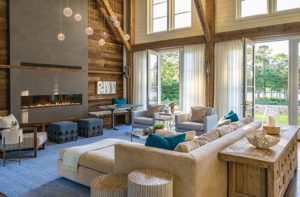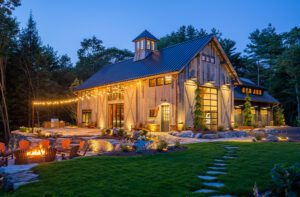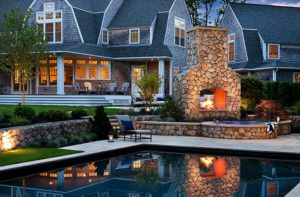Doreen Le May Madden
March 6, 2012
Photography by Webb Chappell
Have you been concerned about, or confused by, the new light bulb regulations coming into force in the U.S. this year? We asked Doreen Le May Madden, principal of Lux Lighting Design in Belmont, Massachusetts, to help us sort through the facts and share some of her thoughts on where home lighting design is headed.
Kyle Hoepner: Can you briefly explain what the Energy Independence and Security Act of 2007 will mean for designers and homeowners?
Doreen Le May Madden: The act requires roughly 25 percent greater efficiency for light bulbs, phased in from 2012 through 2014. (Various specialty bulbs—including appliance bulbs, “rough service” bulbs, colored lights, plant lights and three-way bulbs—are exempt from these requirements, by the way, as are light bulbs of less than 40 watts or more than 150 watts.) This effectively bans the manufacturing and importing of most incandescent light bulbs as they are now designed.
KH: What options exist for replacing incandescent lamps, and what are their various pros and cons?
DM: I cringe when I hear the word replacing, because that seems to indicate an equal to the item that is being replaced. However, there are options.
The technology for compact fluorescent (CFL) lighting is pretty much at its peak, and people pretty much understand now what they get from this kind of lighting. It usually gives a flat effect with no source point for accenting or aiming—that is, general, even lighting that mimics a cloudy day. Earlier fluorescents had a flickering effect that was thought to cause eyestrain and headaches, but this problem has been addressed and does not appear as strongly as it did in the past. The energy savings for CFLs are substantial, but their aesthetic appeal has never been very great.
Electron-stimulated luminescence (ESL) lamps use technology that has been with us for quite some time, in old television tubes. ESLs are supposed to be even more energy-efficient than CFLs, but they have the same lighting effect. Lamp life for CFLs is around 20,000 hours; there is no clear life expectancy yet for ESL lamps. ESL lamps are a new product that may have some future, but it is really too soon to tell.
LED (light-emitting diode) technology is the fastest growing at this time. Many manufacturers are competing to get the most efficient source with the most appeal in appearance and lighting effect.
KH: What about purchase cost?
DM: Very good quality LED products that truly deliver what they promise are more expensive than what we are used to paying. As we have seen in the history of new technologies before, though, eventually the cost will be more palatable—especially, given the lamp life of LEDs, if it is a matter of a purchase only every twenty-five years.
KH: What about aesthetics, particularly the color or quality of light that will be available? In a cold climate like New England’s, the warm, yellow color of incandescent bulbs can go a long way toward making an interior feel cozy and inviting, especially in winter…
DM: They make us feel warm and they literally provide the warmth! Incandescent light sources give out 80 percent heat and 20 percent light.
KH: Are options improving for the quality of light non-incandescent lamps provide?
DM: The incandescent lamp has a rich, warm, balanced light that gives the most appealing effect. It is very close to candlelight, which is what we were initially exposed to as light to live by. Imagine the calming effect of candlelight after a long day’s work. Incandescent dimming can achieve this same warmth of light. LED lighting is available with this warm color. I show clients LED samples and they cannot believe how appealing the color of light is.
KH: Another aesthetics question: What about exposed-bulb fixtures such as chandeliers and sconces? How do the new technologies mesh with older fixtures?
DM: There are some very good options to use in place of typical incandescent candelabra lamps, which have a very low efficiency and lamp life. There are also many other options that are not as attractive or do not fit properly into the luminaires. I am constantly reviewing LED products to see what I can approve and use on my projects.
KH: Is dimmer control possible for the various kinds of lamps?
DM: Dimming is in itself an energy-saving device. The more you dim, the longer the life you get from the lamp. This is not typical of fluorescents, though—dimming has no affect on the lamp life—and the same is true with LEDs. There is no protocol right now on how LEDs dim. Each LED luminaire has to be checked with various dimming companies on what is the best technology for that particular fixture. Right now, LED also doesn’t dim down as much as incandescent and doesn’t get warmer in color as it dims. These issues are changing as we speak, though, and the prognosis looks good to mimic incandescent in these areas.
KH: Will the new regulations affect low-voltage halogen lamps such as the ones in many high-end recessed and track-lighting fixtures?
DM: As a lighting designer you always look for the most efficient light source that does not compromise your design. For more than eight years I have been using efficient, low-voltage halogen lamps that have a very long life and provide me with the beam spreads I need to have. The new LED versions I have seen are not there yet, but a few are very close to achieving the same quality of lighting effect. The new regulations will make these lamps much more attractive to use.
KH: Are there reasons people might want to make these changes regardless of government regulatory requirements?
DM: Absolutely. The competition is fierce to make the best light source, one with all the qualities we are used to, but with much less wattage and longer life. Who wouldn’t want that?
KH: What other concerns should we be thinking about?
DM: One consideration is disposal and recycling. ESL lamps are typically made in part of recyclable plastic and glass, but as with many electronic devices today, the semiconductors and other electronic components are problematic. So disposal of both CFLs (with their mercury content) and ESLs is still an issue…after all, how many people do you know who take the time to recycle their fluorescent lamps?
KH: How do you see all of these changes affecting home lighting design in general?
DM: This part is very exciting. The long life and miniaturization in size of LED products and the addition of OLED (organic LED) to lighting design are creating a whole new way to light buildings. OLEDs provide flat panels of light (they are currently used in TVs as well as some lighting products). I see lighting in the near future not only being integrated even more into building structures (something I have always done for a timeless look and for highlighting architecture), but I see the light sources becoming part of the architecture itself. Imagine glowing walls at the press of a button that can dim and brighten for you! I see lighting design creating harmonious schemes of light and architecture that will be much more appealing, much more efficient and require minimal maintenance.
Share
![NEH-Logo_Black[1] NEH-Logo_Black[1]](https://www.nehomemag.com/wp-content/uploads/2022/08/NEH-Logo_Black1-300x162.jpg)







